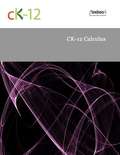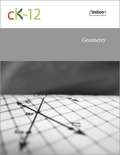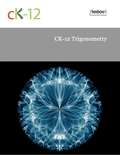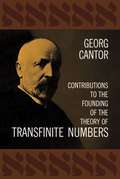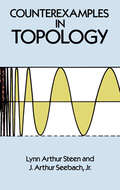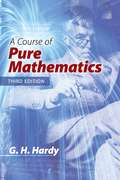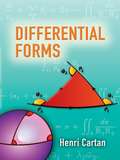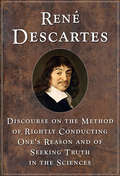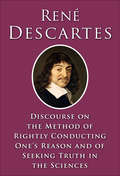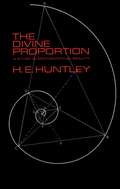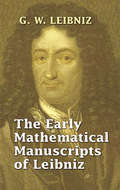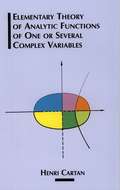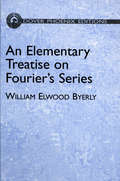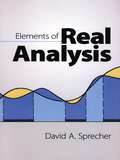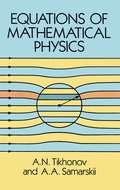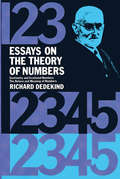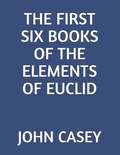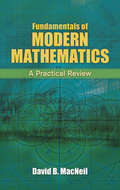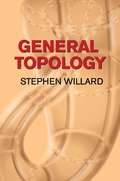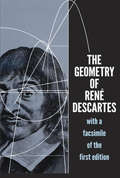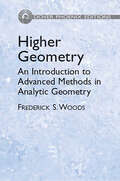- Table View
- List View
CK-12 Calculus
by Ck-12 FoundationCK-12 Foundation's Single Variable Calculus FlexBook covers the following chapters: Functions, Limits, and Continuity - A review of the basics of functions is given. Students use linear approximations to study the limit process, before a more formal treatment of limits is given. Differentiation - Students explore instantaneous rate of change, and the relationship between continuity and differentiability. The Chain Rule and implicit differentiation are reviewed. Applications of Derivatives - Students gain practice with using the derivatives in related rates problems. Additional topics include The First Derivative Test, The Second Derivative Test, limits at infinity, optimization, and approximation errors. Integration - This chapter includes indefinite integrals calculus, initial value problems, definite integrals, the Fundamental Theorem of Calculus, integration by substitution, and numerical integration. Applications of Integration - This chapter includes applications of the definite integral, such as calculating areas between two curves, volumes, length of curves, and other real-world applications in physics and statistics. Transcendental Functions - This chapter includes differentiation and integration of logarithmic and exponential functions, exponential growth and decay, derivatives and integrals involving inverse trigonometric functions, and L'Hospital's Rule. Integration Techniques - Students explore integration by substitution, integration by parts, integration by partial fractions, trigonometric integrals, trigonometric substitutions, and improper integrals. Infinite Series - This chapter introduces the study of sequences and infinite series. The properties presented describe the behavior of a sequence or series, including whether a sequence approaches a number or an infinite series adds to a number.
CK-12 Geometry
by Ck-12 FoundationCK-12 Foundation's Geometry FlexBook covers the following chapters: Basics of Geometry - undefined terms, defined terms, basic postulates of points, lines and planes; distances on a coordinate grid; complementary and supplementary angles; vertical angles; linear pairs and classification of polygons. Reasoning and Proof - inductive reasoning, deductive reasoning, conditional statements, properties of equality and two-column proofs. Parallel and Perpendicular Lines - the parallel line postulate, the perpendicular line postulate, and angles formed by two parallel lines and a non-perpendicular transversal. Congruent Triangles - the Triangle Sum theorem, triangle congruence, the SSS and ASA postulates, the AAS congruence theorem, two-column and flow proofs, the HL congruence theorem, AAA and SSA relationships, isosceles and equilateral triangles. Relationships Within Triangles - the midsegment theorem, the perpendicular bisector theorem, the angle bisector theorem, the concurrency of medians theorem, Napoleon's theorem, and the triangle inequality theorems. Quadrilaterals - interior angles of convex quadrilaterals, classifying quadrilaterals, properties of parallelograms, properties of rhombi, rectangles and squares, and properties of trapezoids. Similarity - ratio and proportion, properties of similar polygons, AAA and AA rules for similar triangles, using SSS and SAS to solve problems about similar triangles, identifying proportional segments in triangles and similarity transformations. Right Triangle Trigonometry - using the Pythagorean theorem when working with right triangles, classification of triangles, the converse of the Pythagorean theorem, using the geometric mean, properties of special right triangles, and trigonometric ratios. Circles - relationships between congruent and similar circles, the equation of a circle, tangent lines, arc measures, chords, inscribed angles, and angles formed by chords, secants and tangents. Perimeter and Area - finding the area of polygons, using scale drawings or models, finding the circumference of a circle, areas of circles and sectors, calculating the areas and perimeters of regular polygons and geometric probability. Transformations - transformations of figures in two-dimensional space including translations, reflections, rotations and dilations.
CK-12 Trigonometry
by Ck-12 FoundationCK-12 Foundation's Trigonometry FlexBook covers the following chapters: Trigonometry and Right Angles - introduction to the trigonometric functions. Circular Functions - introduction to radian measure, circular functions and periodic functions. Trigonometric Identities - confirm, verify and derive various trigonometric identities. Inverse Functions and Trigonometric Equations - inverse functions to trigonometric functions, and will apply the domain, range and quadrants of the six inverse trigonometric functions to evaluate expressions. Triangles and Vectors - introduction to vectors and vector applications. Polar Equations and Complex Numbers - plot points in a polar coordinate system, graph and recognize limaçons and cardiods, and work with real-world applications involving polar coordinates and polar equations.
Collaborative Statistics
by Barbara Illowsky Susan DeanCollaborative Statistics was written by Barbara Illowsky and Susan Dean, faculty members at De Anza College in Cupertino, California. The textbook was developed over several years and has been used in regular and honors-level classroom settings and in distance learning classes. This textbook is intended for introductory statistics courses being taken by students at two- and four-year colleges who are majoring in fields other than math or engineering. Intermediate algebra is the only prerequisite. The book focuses on applications of statistical knowledge rather than the theory behind it.
Contributions to the Founding of the Theory of Transfinite Numbers (Dover Books on Mathematics)
by Georg CantorOne of the greatest mathematical classics of all time, this work established a new field of mathematics which was to be of incalculable importance in topology, number theory, analysis, theory of functions, etc., as well as in the entire field of modern logic. It is rare that a theory of such fundamental mathematical importance is expressed so simply and clearly: the reader with a good grasp of college mathematics will be able to understand most of the basic ideas and many of the proofs.Cantor first develops the elementary definitions and operations of cardinal and ordinal numbers and analyzes the concepts of "canlinality" and "ordinality." He covers such topics as the addition, multiplication, and exponentiation of cardinal numbers, the smallest transfinite cardinal number, the ordinal types of simply ordered aggregates, operations on ordinal types, the ordinal type of the linear continuum, and others. He then develops a theory of well-ordered aggregates, and investigates the ordinal numbers of well-ordered aggregates and the properties and extent of the transfinite ordinal numbers.An 82-page introduction by the eminent mathematical historian Philip E. B. Jourdain first sketches the background of Cantor's theory, discussing the contributions of such predecessors as Veicrstrass, Cauchy, Dedekind, Dirichlet, Riemann, Fourier, and Hankel; it then traces the development of the theory by summarizing and analyzing Cantor's earlier work. A bibliographical note provides information on further investigations in the theory of transfinite numbers by Frege, Peano, Whitehead, Russell, etc.
Counterexamples in Topology (Dover Books on Mathematics)
by Lynn Arthur Steen J. Arthur Seebach Jr.According to the authors of this highly useful compendium, focusing on examples is an extremely effective method of involving undergraduate mathematics students in actual research. It is only as a result of pursuing the details of each example that students experience a significant increment in topological understanding. With that in mind, Professors Steen and Seebach have assembled 143 examples in this book, providing innumerable concrete illustrations of definitions, theorems, and general methods of proof. Far from presenting all relevant examples, however, the book instead provides a fruitful context in which to ask new questions and seek new answers.Ranging from the familiar to the obscure, the examples are preceded by a succinct exposition of general topology and basic terminology and theory. Each example is treated as a whole, with a highly geometric exposition that helps readers comprehend the material. Over 25 Venn diagrams and reference charts summarize the properties of the examples and allow students to scan quickly for examples with prescribed properties. In addition, discussions of general methods of constructing and changing examples acquaint readers with the art of constructing counterexamples. The authors have included an extensive collection of problems and exercises, all correlated with various examples, and a bibliography of 140 sources, tracing each uncommon example to its origin.This revised and expanded second edition will be especially useful as a course supplement and reference work for students of general topology. Moreover, it gives the instructor the flexibility to design his own course while providing students with a wealth of historically and mathematically significant examples. 1978 edition.
A Course of Pure Mathematics (Cambridge Mathematical Library)
by G. H. HardyOriginally published in 1908, this classic calculus text transformed university teaching and remains a must-read for all students of introductory mathematical analysis. Clear, rigorous explanations of the mathematics of analytical number theory and calculus cover single-variable calculus, sequences, number series, and properties of cos, sin, and log. Meticulous expositions detail the fundamental ideas underlying differential and integral calculus, the properties of infinite series, and the notion of limit. An expert in the fields of analysis and number theory, author G. H. Hardy taught for decades at both Cambridge and Oxford. A Course of Pure Mathematics is suitable for college and high school students and teachers of calculus as well as fans of pure math. Each chapter includes demanding problem sets that allow students to apply the principles directly, and four helpful Appendixes supplement the text.
Differential Forms (Dover Books on Mathematics)
by Henri Cartan"Cartan's work provides a superb text for an undergraduate course in advanced calculus, but at the same time it furnishes the reader with an excellent foundation for global and nonlinear algebra."--Mathematical Review"Brilliantly successful."--Bulletin de l'Association des Professeurs de Mathematiques"The presentation is precise and detailed, the style lucid and almost conversational . . . clearly an outstanding text and work of reference."--AnnalesCartan's Formes Differentielles was first published in France in 1967. It was based on the world-famous teacher's experience at the Faculty of Sciences in Paris, where his reputation as an outstanding exponent of the Bourbaki school of mathematics was first established.Addressed to second- and third-year students of mathematics, the material skillfully spans the pure and applied branches in the familiar French manner, so that the applied aspects gain in rigor while the pure mathematics loses none of its dignity. This book is equally essential as a course text, as a work of reference, or simply as a brilliant mathematical exercise.
Discourse on the Method of Rightly Conducting One's Reason and of Seeking Truth in the Sciences
by René DescartesIn this work, René Descartes (1596-1650) outlines his "Method," which attempts to apply mathematical reasoning to all fields of inquiry. Starting with universal doubt, Descartes passes via his celebrated "I think, therefore I am," to the certainty of the existence of God.
Discourse on the Method of Rightly Conducting One's Reason and of Seeking Truth in the Sciences
by René DescartesIn this work,René Descartes (1596-1650) outlines his "Method," which attempts to apply mathematical reasoning to all fields of inquiry. Starting with universal doubt, Descartes passes via his celebrated "I think, therefore I am," to the certainty of the existence of God.
The Divine Proportion
by H. E. HuntleyUsing simple mathematical formulas, most as basic as Pythagoras's theorem and requiring only a very limited knowledge of mathematics, Professor Huntley explores the fascinating relationship between geometry and aesthetics. Poetry, patterns like Pascal's triangle, philosophy, psychology, music, and dozens of simple mathematical figures are enlisted to show that the "divine proportion" or "golden ratio" is a feature of geometry and analysis which awakes answering echoes in the human psyche. When we judge a work of art aesthetically satisfying, according to his formulation, we are making it conform to a pattern whose outline is laid down in simple geometrical figures; and it is the analysis of these figures which forms the core of Professor Huntley's book.For the philosopher, scientist, poet, art historian, music listener, artist, as well as the general reader who wants to understand more about the fascinating properties of numbers, this is a beautifully written, exciting account of the search for a naturally manifested aesthetic that has occupied man since he first asked the question "why?""This is a delightful book to read. . . . It wanders here and there through some of the most attractive byways of simple mathematics, returning always to the oddities and pleasures of the golden section. This is a browser's book — a happy, untidy traveling or bedside book for those who know how to enjoy the charm of numbers and shapes." — Dr. J. Bronowski, The Salk Institute.
The Early Mathematical Manuscripts of Leibniz
by G. W. Leibniz J. M. ChildThe manuscripts and correspondence of Leibniz possess a special interest: they are invaluable as aids to the study of their author's part in the invention and development of the infinitesimal calculus. In addition, the main ideas behind Leibniz's philosophical theories lay here, in his mathematical work.This volume consists of two sections. The first part features Leibniz's own accounts of his work, and the second section comprises critical and historical notes and essays. An informative Introduction leads to the "postscript" to Leibniz's 1703 letter to James Bernoulli, his "Historia et Origio Calculi Differentialis," and manuscripts of the period 1673-77. Essays by the distinguished scholar C. I. Gerhardt follow--Leibniz in London and Leibniz and Pascal, along with additional letters and manuscripts by Leibniz.
Elementary Algebra
by Denny Burzynski Wade EllisElementary Algebra is a work text that covers the traditional topics studied in a modern elementary algebra course. It is intended for students who (1) have no exposure to elementary algebra, (2) have previously had an unpleasant experience with elementary algebra, or (3) need to review algebraic concepts and techniques.
Elementary Theory of Analytic Functions of One or Several Complex Variables
by Henri CartanNoted mathematician offers basic treatment of theory of analytic functions of a complex variable, touching on analytic functions of several real or complex variables as well as the existence theorem for solutions of differential systems where data is analytic. Also included is a systematic, though elementary, exposition of theory of abstract complex manifolds of one complex dimension. Topics include power series in one variable, holomorphic functions, Cauchy’s integral, more. Exercises. 1973 edition.
An Elementary Treatise on Fourier's Series: and Spherical, Cylindrical, and Ellipsoidal Harmonics, with Applications to Problems in Mathematical
by William Elwood ByerlyOriginally published over a century ago, this work remains among the most useful and practical expositions of Fourier's series, and spherical, cylindrical, and ellipsoidal harmonics. The subsequent growth of science into a diverse range of specialties has enhanced the value of this classic, whose thorough, basic treatment presents material that is assumed in many other studies but seldom available in such concise form. The development of functions, series, and their differential equations receives detailed explanations, and throughout the text, theory is applied to practical problems, with the solutions fully worked out. In addition, 190 problems, many with hints, are included. 1893 edition. Appendix of 6 tables.
Elements of Real Analysis
by David A. SprecherThis classic text in introductory analysis delineates and explores the intermediate steps between the basics of calculus and the ultimate stage of mathematics: abstraction and generalization.Since many abstractions and generalizations originate with the real line, the author has made it the unifying theme of the text, constructing the real number system from the point of view of a Cauchy sequence (a step which Dr. Sprecher feels is essential to learn what the real number system is).The material covered in Elements of Real Analysis should be accessible to those who have completed a course in calculus. To help give students a sound footing, Part One of the text reviews the fundamental concepts of sets and functions and the rational numbers. Part Two explores the real line in terms of the real number system, sequences and series of number and the structure of point sets. Part Three examines the functions of a real variable in terms of continuity, differentiability, spaces of continuous functions, measure and integration, and the Fourier series.An especially valuable feature of the book is the exercises which follow each section. There are over five hundred, ranging from the simple to the highly difficult, each focusing on a concept previously introduced.
EPUBTest Accessibility Tests Mathematics
by DAISY Consortium Transition to EPUB 3 and the DIAGRAM Center Standards WGMath Recommendation for EPUB. This is a test book from epubtest.org.
Equations of Mathematical Physics
by A. A. Samarskii A. N. TikhonovMathematical physics plays an important role in the study of many physical processes -- hydrodynamics, elasticity, and electrodynamics, to name just a few. Because of the enormous range and variety of problems dealt with by mathematical physics, this thorough advanced undergraduate- or graduate-level text considers only those problems leading to partial differential equations. Contents:I. Classification of Partial Differential EquationsII. Evaluations of the Hyperbolic TypeIII. Equations of the Parabolic TypeIV. Equations of Elliptic TypeV. Wave Propagation in SpaceVI. Heat Conduction in SpaceVII. Equations of Elliptic Type (Continuation)The authors -- two well-known Russian mathematicians -- have focused on typical physical processes and the principal types of equations dealing with them. Special attention is paid throughout to mathematical formulation, rigorous solutions, and physical interpretation of the results obtained. Carefully chosen problems designed to promote technical skills are contained in each chapter, along with extremely useful appendixes that supply applications of solution methods described in the main text. At the end of the book, a helpful supplement discusses special functions, including spherical and cylindrical functions.
Essays on the Theory of Numbers (Dover Books on Mathematics)
by Richard DedekindThis volume contains the two most important essays on the logical foundations of the number system by the famous German mathematician J. W. R. Dedekind. The first presents Dedekind's theory of the irrational number-the Dedekind cut idea-perhaps the most famous of several such theories created in the 19th century to give a precise meaning to irrational numbers, which had been used on an intuitive basis since Greek times. This paper provided a purely arithmetic and perfectly rigorous foundation for the irrational numbers and thereby a rigorous meaning of continuity in analysis.The second essay is an attempt to give a logical basis for transfinite numbers and properties of the natural numbers. It examines the notion of natural numbers, the distinction between finite and transfinite (infinite) whole numbers, and the logical validity of the type of proof called mathematical or complete induction.The contents of these essays belong to the foundations of mathematics and will be welcomed by those who are prepared to look into the somewhat subtle meanings of the elements of our number system. As a major work of an important mathematician, the book deserves a place in the personal library of every practicing mathematician and every teacher and historian of mathematics. Authorized translations by "Vooster " V. Beman.
The First Six Books of the Elements of Euclid: With Notes
by John Casey EuclidThe First Six Books of the Elements of Euclid With Notes by John Casey and Euclid
Fundamentals of Mathematics
by Denny Burzynski Wade EllisFundamentals of Mathematics is a work text that covers the traditional topics studied in a modern prealgebra course, as well as topics of estimation, elementary analytic geometry, and introductory algebra. It is intended for students who have had a previous course in prealgebra, wish to meet the prerequisite of a higher level course such as elementary algebra, and need to review fundamental mathematical concepts and techniques.
Fundamentals of Modern Mathematics: A Practical Review (Dover Books on Mathematics)
by David B. MacNeilStudents and others wishing to know a little more about the practical side of mathematics will find this volume a highly informative resource. An excellent supplement to college and high school courses as well as a guide to independent study, the book covers examples of pure mathematics as well as concepts of applied mathematics useful for solving problems that arise in business, industry, science, and technology.Contents include examinations of the theory of sets, numbers and groups; matrices and determinants; probability, statistics, and quality control; and game theory. Additional subjects include inequalities, linear programming, and the transportation problem; combinatorial mathematics; transformations and transforms; and numerical analysis. Accessible explanations of important concepts feature a total of more than 150 diagrams and graphs, in addition to worked-out examples with step-by-step explanations of methods. Answers to exercises and problems appear at the end.
General Topology
by Stephen WillardAmong the best available reference introductions to general topology, this volume is appropriate for advanced undergraduate and beginning graduate students. Its treatment encompasses two broad areas of topology: "continuous topology," represented by sections on convergence, compactness, metrization and complete metric spaces, uniform spaces, and function spaces; and "geometric topology," covered by nine sections on connectivity properties, topological characterization theorems, and homotopy theory. Many standard spaces are introduced in the related problems that accompany each section (340 exercises in all). The text's value as a reference work is enhanced by a collection of historical notes, a bibliography, and index. 1970 edition. 27 figures.
The Geometry of René Descartes: with a Facsimile of the First Edition
by René DescartesThis is an unabridged republication of the definitive English translation of one of the very greatest classics of science. Originally published in 1637, it has been characterized as "the greatest single step ever made in the progress of the exact sciences" (John Stuart Mill); as a book which "remade geometry and made modern geometry possible" (Eric Temple Bell). It "revolutionized the entire conception of the object of mathematical science" (J. Hadamard).With this volume Descartes founded modern analytical geometry. Reducing geometry to algebra and analysis and, conversely, showing that analysis may be translated into geometry, it opened the way for modern mathematics. Descartes was the first to classify curves systematically and to demonstrate algebraic solution of geometric curves. His geometric interpretation of negative quantities led to later concepts of continuity and the theory of function. The third book contains important contributions to the theory of equations.This edition contains the entire definitive Smith-Latham translation of Descartes' three books: Problems the Construction of which Requires Only Straight Lines and Circles; On the Nature of Curved Lines; and On the Construction of Solid and Supersolid Problems. Interleaved page by page with the translation is a complete facsimile of the 1637 French text, together with all Descartes' original illustrations; 248 footnotes explain the text and add further bibliography.
Higher Geometry: An Introduction to Advanced Methods in Analytic Geometry
by Frederick S. WoodsFor students of mathematics with a sound background in analytic geometry and some knowledge of determinants, this volume has long been among the best available expositions of advanced work on projective and algebraic geometry. Developed from Professor Woods' lectures at the Massachusetts Institute of Technology, it bridges the gap between intermediate studies in the field and highly specialized works.With exceptional thoroughness, it presents the most important general concepts and methods of advanced algebraic geometry (as distinguished from differential geometry). It offers a thorough study of one-, two-, three-, and four-dimensional coordinated systems, the concepts they entail, and their associated geometrical elements. This study culminates with a discussion of n-dimensional geometry in an abstract sense, of which the earlier subjects form concrete illustrations.As each system of coordinates is introduced, the meaning of the linear and quadratic equations is studied, with principal emphasis on the interpretation of equations as well as on a knowledge of useful geometrical facts. The principle of duality is kept at the forefront, and the nature of imaginary elements and the conventional character of the locus of infinity, dependent upon the type of coordinates used, are carefully explained.
